A Concise History of Northwest Art opens with Michael Brophy‘s clear cut along a logging road:
January, 1997. Oil on canvas, 78 x 95 ½ inches.
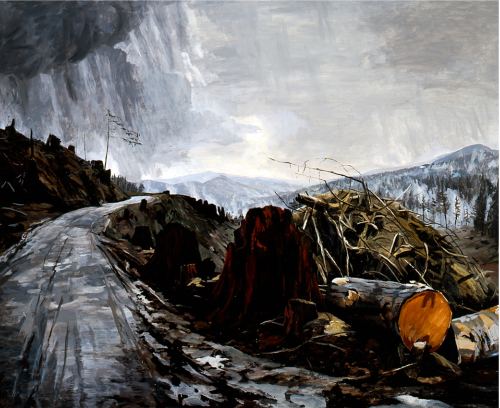 How brilliant it would have been to pair it with a Kenneth Callahan clear cut from the 1930s. Brophy has the sky drifting across mud furrows, the mountains serene in the distance and the exposed face of a cut tree shining low like a setting sun, but Callahan has the forest world convulsed, with no reassuring grace notes.
How brilliant it would have been to pair it with a Kenneth Callahan clear cut from the 1930s. Brophy has the sky drifting across mud furrows, the mountains serene in the distance and the exposed face of a cut tree shining low like a setting sun, but Callahan has the forest world convulsed, with no reassuring grace notes.
The Tacoma Art Museum does not have such a Callahan in its collection or it would have made an appearance. (Nor could I find one online.) Organized by the museum’s senior curator, Rock Hushka, A Concise History draws entirely from the museum’s holdings, which are impressive in their range and depth. Instead of a Callahan, what hangs beside Brophy is a meek Sidney Lawrence, probably from the 1930s, Mt. McKinley, Alaska, doing Lawrence no favors.
Hushka would have been well advised to give Brophy the entry wall. Experiences on the same frequency tend to fuse or spark. Lawrence is overwhelmed and deserves better. (His own space or a more sympathetic companion could have brought out his subtle delicacies.)
What a smart title. The word concise tends to cut off the inevitable complaints: Why not x? Surely if you have y, you need w. My only real compliant is that Huska didn’t take the word seriously enough. Exhibits at the Tacoma Art Museum tend toward salon style. They’re packed to the rafters. While I enjoyed this show, its density overwhelms the particular with the general.
I like the exhibit’s first half of the 20th Century, which favors the lesser knowns, such as Ambrose Patterson, Peter Camfferman, Charles Heaney (It’s worth a trip to the Portland Art Museum to see the Heaney’s, lamentably underrepresented in Seattle), Walter Isaacs, Zama Vanessa Helder and Kenjiro Nomura.
Kenjiro Nomura,
Puget Sound,1933. Oil on canvas, 19 5/8 x 23 ¾ inches.
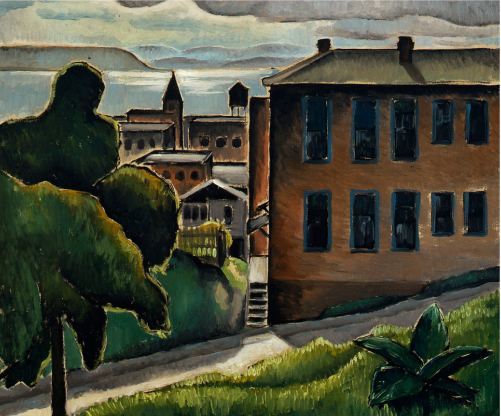 With light rimming his forms, Nomura conveys a quiet kind of Surrealism that predates Wayne Tiebaud’s. With painter Kamekichi Tokita, Nomura ran
With light rimming his forms, Nomura conveys a quiet kind of Surrealism that predates Wayne Tiebaud’s. With painter Kamekichi Tokita, Nomura ran
a sign-painting business before the war. In the 1930s they managed to give some work to Paul Horiuchi, who remembered painting large hula dancers and octopuses on billboards for them. The three would go out sketching on Sunday afternoons.
By the late 1930s such excursions were no longer safe. Horiuchi said he
and Nomura were on the University Bridge one day, drawing together, when
somebody reported them to the police as suspicious characters. After
investigating, the police told them to stop sketching outside.
Nomura and Tokita were deported to camp Minidoka in Idaho, and neither managed to regain their stride as artists afterward. Nomura had a lovely, dreamy style before the war,
turning Seattle into his own kind of paradise. With their
loose, sensuous line, his softly colored hedges and buildings seem to
be only pausing in space before floating away.
(For more on the theme of Seattle’s Japanese -American artists of the World War II generation, see review of Barbara John’s Views and Visions at the Seattle Art Museum in 1990.)
The thing about major figures, however, is that they tend to dominate. Morris Graves and Jacob Lawrence own the first half of this exhibit’s the 20th Century. Claiming early Lawrence for Northwest art is a stretch, as he didn’t move to the region until 1971, when offered full-professor tenure at the University of Washington.
Jacob Lawrence, Street Orator, 1936
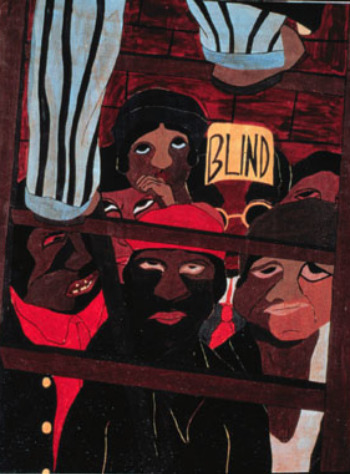 When you’ve got it, flaunt it. The Seattle Art Museum does not own a Lawrence as good as this one.
When you’ve got it, flaunt it. The Seattle Art Museum does not own a Lawrence as good as this one.
Graves’ Chalice Holding the Stimson Mill, also from 1936, has the kind of fierce, light-struck landscape furrows that rival Anslem Kiefer’s, in deeper and far more radiant hues. Early Graves struck his colors like a gong, and they continue to reverberate.
The Mark Tobey here (Point of Intersection, 1949) is fine if a little academic, but representations of Guy Anderson and Callahan should have been left in the bins. Getting better Andersons could not be the impossible dream.
Rounding out the 20th-Century’s first half is Spencer Moseley‘s Olympia Landscape from 1947. Moseley is best known these days for arranging the Jacob Lawrence hire at the University of Washington, but what a lively painter he was. This painting does not even hint at the bebopping astringency of his mature work, but there’s real muscle in his iced blue waters.
Mid-20th Century art grips down and wakens in Seattle, seen here in the work of Michael Spafford, Robert C. Jones, Fay Jones, Alden Mason and William Ivey.
When Chuck Close met Willem de Kooning, Close told him it was nice to meet a man who’d painted more de Koonings than he had. One of those faux-de Kooning’s is in this show, from Close’s student days in the early 1960s at the University of Washington. (Only in the Northwest does evidence of this early source live on.)
As the exhibit edges towards the present, women begin to make more than an occasional appearance, including Marsha Burns, Alice Wheeler, Claire Cowie, Marie Watt and Susan Seubert.
Marie
Watt, Tear Down This Wall, 2007. Reclaimed wool blankets, satin
binding, and thread, 61 x 64 inches
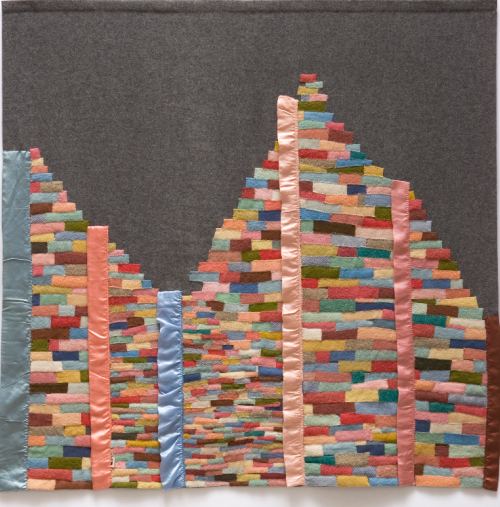 I love Seubert’s series, 10 Most Popular
I love Seubert’s series, 10 Most Popular
Places to Dump a Body in the Columbia River Gorge, from 1998. The museum owns all ten prints.
Seubert, Lewis and Clark State Park, gelatin silver
print, artists proof from an edition of 10; 16 x 20 inches.
 In this telling of the Northwest tale, painters rule, not only in the past but in the present. That dominance represents a selective fiction. All we can ask of fiction is that it be convincing, and this one is, at least for the duration of the show.
In this telling of the Northwest tale, painters rule, not only in the past but in the present. That dominance represents a selective fiction. All we can ask of fiction is that it be convincing, and this one is, at least for the duration of the show.
Mark Takamichi Miller, Untitled, 1999. Acrylic on canvas, 72 x
64 inches.
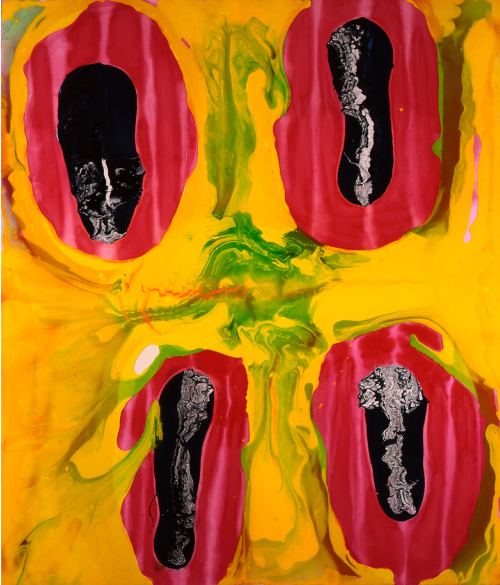 Through May 23.
Through May 23.



During my hunting days I’ve been along those wet, soggy, muddy clearcuts so many many times. Brophy captures them expertly and with just the right feeling.
This report by you Regina, Seems to touch all the bases in such a way that the word “concise” is most appropriate. Admittedly, it does bother me that the name of Bill Cumming is nowhere to be found. I’m guessing that his work was’nt part of this collection, nevertheless I’d feel that with some of the names that have been tossed around here that it was surprising not to see his name mentioned.
This is a great article. I will make the trip from Seattle to Tacoma. As an implant Northwest artist of 10+ years it is nice to familiarize myself with so many great talents from the region. Thank You.
Regina, nice piece on what looks like a great show (props to Rock). I recall a Callahan winter scene with figure (watercolor or oil sketch) from the Bellevue Art Museum collection that went to TAM’s collection in circa 1998…Miriam Sternberg and I showed it in a little 1999 or 2000 historical show that accompanied a big snowboard culture show BAM hosted…the Callahan was quietly spectacular and looked, to us, like he was totally reveling in some new paints or a new jacket his friend (Anderson?) was wearing or both. Brian